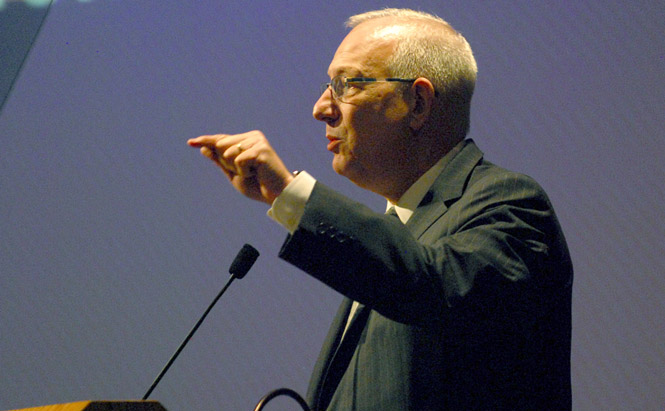Lefton gives State of the University Address
Kent State University President Lester Lefton presented his fifth annual State of the University speech on Sept. 22nd to a packed Kiva. “The achievements of Kent State have exceeded even my greatest expectations,” said Lefton in as address that highlighted the university’s achievements over the last five years. Photo Sam Verbulecz.
September 22, 2011
Lefton’s achievements
In his State of the University Address, President Lefton looked back on the successes of his first 60 months.
- Record-breaking student enrollment
- A record 4,284 freshmen are welcomed to the main campus
- Record-breaking fundraising
- Centennial Campaign reaches $250 million earlier this month
- Innovative orientation programs
- Online GPS (Graduation Planning System), Destination Kent State helping students adapt
- Emphasis on building a diverse student environment
- Alfreda Brown, Vice President for Diversity, Equity and Inclusion, addresses diversity issues
- $100 million “downtown renaissance”
- New restaurants, shops, a hotel, conference center and extended Esplanade connect the university to downtown Kent
President Lester Lefton proposed an option Thursday for faculty to choose a longer tenure timeline during his fifth annual State of the University Address.
Lefton’s address reviewed the successes of his first five years as university president, his questions for the state of higher education and his major priorities for Kent State in the coming year.
Faculty Growth
The president asked faculty to consider a choice to follow a 10-year tenure plan instead of the typical six- or five-year plan.
Lefton said his “modest proposal” would help ease the enormous workload and stress tenure-track faculty face in order to prove their academic merit and productivity.
“Those who choose the extended tenure timeline would have more time to secure grants in a fiercely competitive funding environment, more time to write publication-caliber articles and chapters and more time to devote to family responsibilities,” Lefton said.
Lefton said the change would be part of a larger strategy to grow and support Kent State faculty. Along with the tenure extension, he said, removing the gender barrier in science, technology, engineering and mathematics education is equally important.
“Although America has an urgent need for professionals in STEM (science, technology, engineering and math fields), women are underrepresented to a very large degree,” Lefton said.
He said Kent State has partnered with five other public research universities to create Institutions Developing Excellence in Academic Leadership, a team funded by the National Science Foundation. He hopes to support the project with additional grants in the future, but said a Kent State task force, led by Alfreda Brown, vice president for diversity, equity and inclusion, is already at work.
“The task force will recommend actions to promote the participation and success of underrepresented groups at all levels of STEM education and research,” he said. “We will translate as many task force recommendations into action as possible.”
Lefton said he expects the specific recommendations this semester, and he will keep the university informed of its progress.
Timely Graduation
Lefton called for a university-wide effort in developing a more effective retention strategy.
“We have written a stunning success story when it comes to enrolling students,” Lefton said. “We must achieve equal success in helping students reach the finish line.”
Lefton said in order to improve the 72 to 78 percent freshman-to-sophomore retention rate, the university must optimize the resources it already has. For example, student advisors must be proactively involved in their students’ success, faculty members must especially focus on the students who are struggling and groundskeepers must make the campus look more attractive.
“In short, every time we show that we care about our work — every time we put excellence into action — we have an impact on retention,” Lefton said.
The university will continue to offer such resources as the GPS graduation roadmap and Destination: Kent State, he said.
Emphasis on Research
The president announced a new vice president to help the university reach its “sweet spot” as a public research university.
Dr. W. Grant McGimpsey, vice president for research, will design a plan to improve Kent State’s research enterprise in terms of productivity and achievement, he said.
“Although more than a few faculty members are hitting their ideas and discoveries out of the park, we have not found our institutional sweet spot for research and creative activity,” Lefton said.
McGimpsey’s plan will include increasing the number of grant submissions to federal funding agencies, hiring in areas particularly ripe for positive research growth and rewarding outstanding scholarship in the arts and humanities just as much as in the sciences.
“We will (not) focus solely on high-profile areas like liquid crystals,” Lefton said.
A review of McGimpsey’s work will be ready by January, he said.
Globalization
Lefton said in order for the university to keep pace with the global economy, it needs a comprehensive, long-term plan for global education.
He said he spoke with the Board of Trustees about investments the university must make if they are to be internationally successful in the future.
“This conversation will not be confined to the boardroom table,” Lefton said. “Developing the best roadmap for global education at Kent State requires broad consultation across our campuses.”
The president said he has asked Dr. Mary Anne Saunders, executive director of the Office of Global Education, to begin consulting with faculty about how to innovate globally.
Contact Daniel Moore at [email protected].












